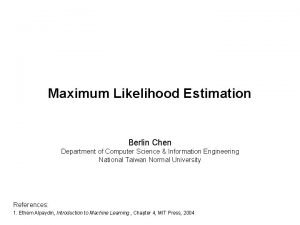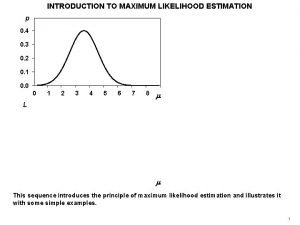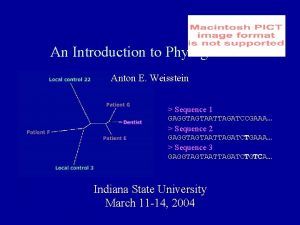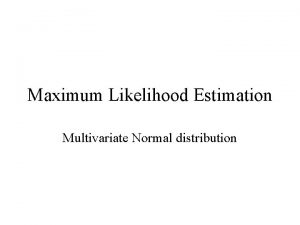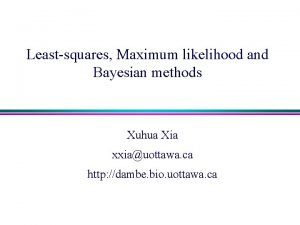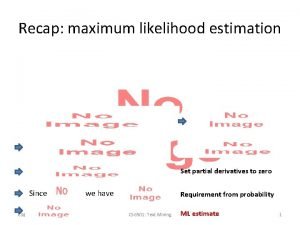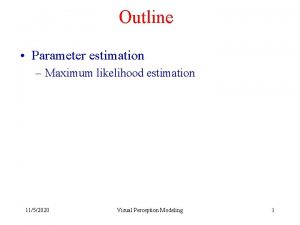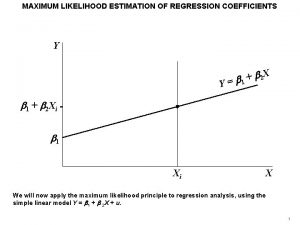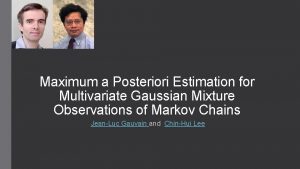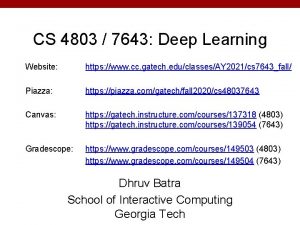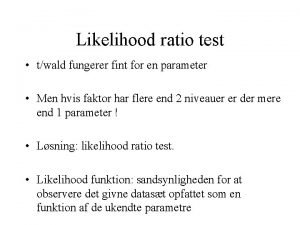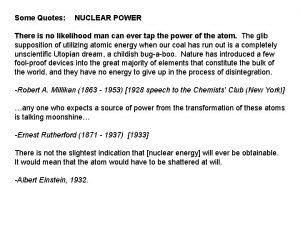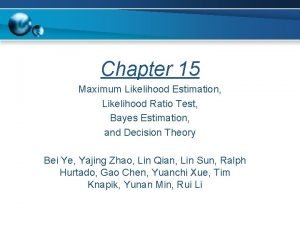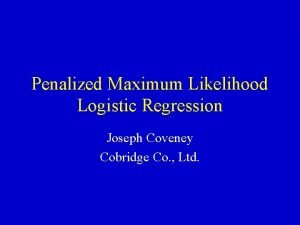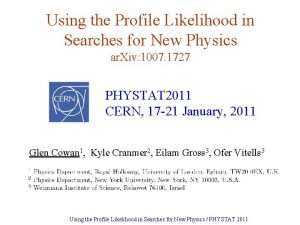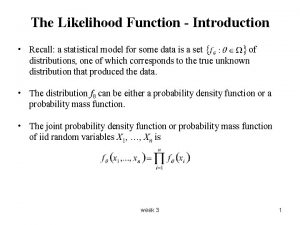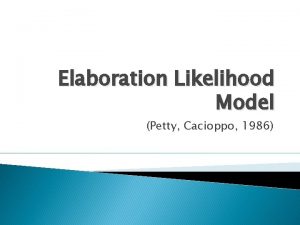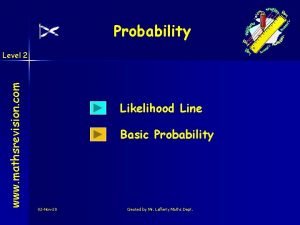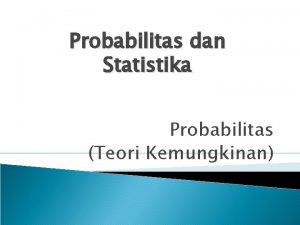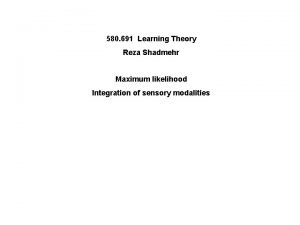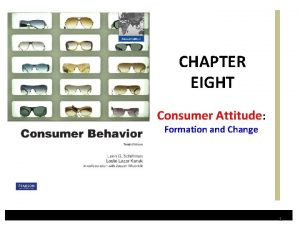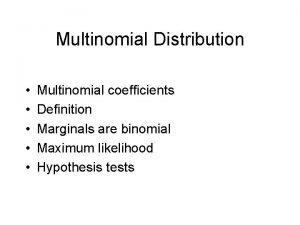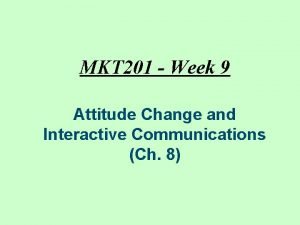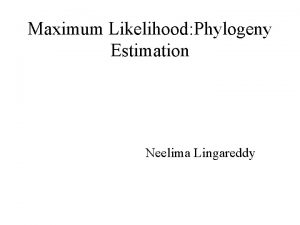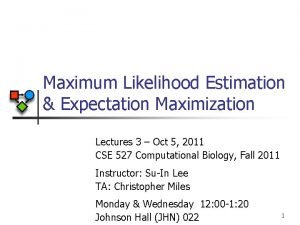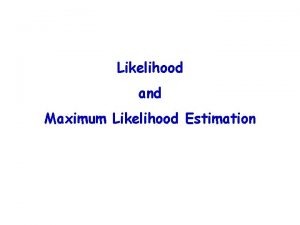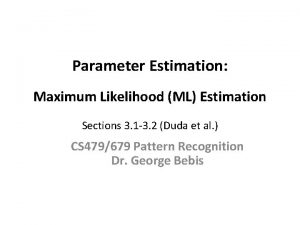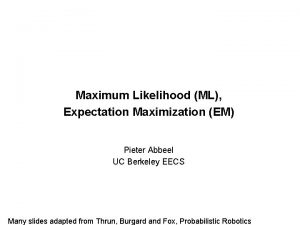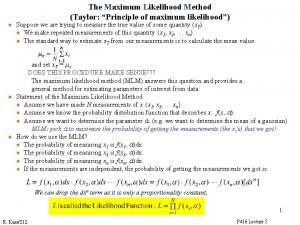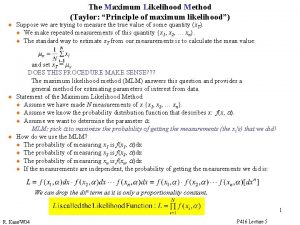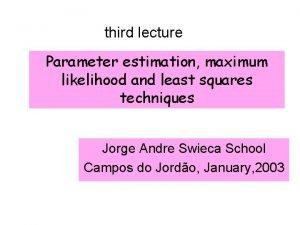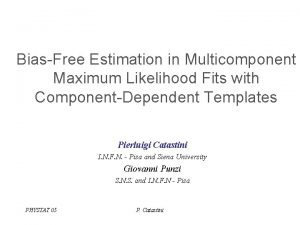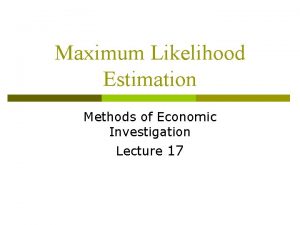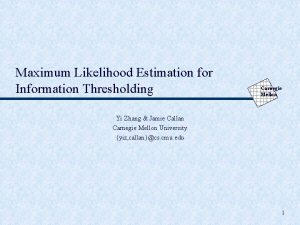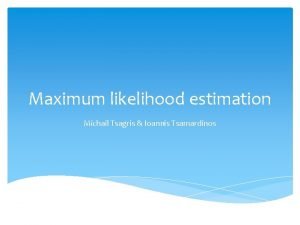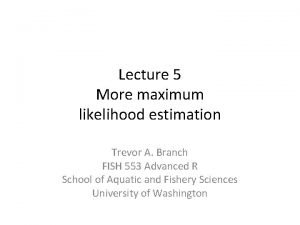CS 589 Fall 2020 Maximum likelihood estimation Expectation






























![Interpreting content of corpora [Mei et al. 07] Topic q 1 • How do Interpreting content of corpora [Mei et al. 07] Topic q 1 • How do](https://slidetodoc.com/presentation_image_h2/21749f05ff38a86b72e5b15c8aba2c75/image-31.jpg)
![Relevance: the Zero-Order Score [Mei et al. 07] • Intuition: prefer phrases well covering Relevance: the Zero-Order Score [Mei et al. 07] • Intuition: prefer phrases well covering](https://slidetodoc.com/presentation_image_h2/21749f05ff38a86b72e5b15c8aba2c75/image-32.jpg)
![Relevance: the First-Order Score [Mei et al. 07] • Intuition: prefer phrases with similar Relevance: the First-Order Score [Mei et al. 07] • Intuition: prefer phrases with similar](https://slidetodoc.com/presentation_image_h2/21749f05ff38a86b72e5b15c8aba2c75/image-33.jpg)
![Topic labels [Mei et al. 07] sampling 0. 06 estimation 0. 04 approximate 0. Topic labels [Mei et al. 07] sampling 0. 06 estimation 0. 04 approximate 0.](https://slidetodoc.com/presentation_image_h2/21749f05ff38a86b72e5b15c8aba2c75/image-34.jpg)

![Iterative Causal Topic Modeling [Kim et al. 13] Topic Modeling Text Stream Sept. 2001 Iterative Causal Topic Modeling [Kim et al. 13] Topic Modeling Text Stream Sept. 2001](https://slidetodoc.com/presentation_image_h2/21749f05ff38a86b72e5b15c8aba2c75/image-36.jpg)

![Topics in NY Times Correlated with Stocks [Kim et al. 13]: June 2000 ~ Topics in NY Times Correlated with Stocks [Kim et al. 13]: June 2000 ~](https://slidetodoc.com/presentation_image_h2/21749f05ff38a86b72e5b15c8aba2c75/image-38.jpg)
![Major Topics in 2000 Presidential Election [Kim et al. 13] Top Three Words in Major Topics in 2000 Presidential Election [Kim et al. 13] Top Three Words in](https://slidetodoc.com/presentation_image_h2/21749f05ff38a86b72e5b15c8aba2c75/image-39.jpg)

- Slides: 40

CS 589 Fall 2020 Maximum likelihood estimation Expectation maximization Instructor: Susan Liu TA: Huihui Liu Stevens Institute of Technology 1

Recap of Lecture 2 • RSJ: no parameter • BM 25: Due to the formulation of two-Poisson, parameters are difficult to estimate, so use a parameter free version to replace it • Language model based retrieval model • Leave-one-out • EM algorithm 2

Maximum likelihood estimation • RSJ: PRP: rank documents by • Language model 3

Today’s lecture • Maximum likelihood estimation • Expectation maximization • Coin-topic problem • Using EM algorithm to remove stop words • Mixture of topic models • Probabilistic latent semantic analysis • PLSA with partial labels 4

Maximum likelihood estimation observations e. g. , mice weights likelihood parameters If the optimal solution is within ’s space : at 5

Expectation maximization algorithm • How to estimate the optimal ? • Expectation maximization (EM) algorithm: • Relies on the concept of complete data space • Iterative and alternative between conditional expectation and maximization steps l(theta): Incomplete data space: observation, e. g. , documents l_{cd}(theta): Complete data space: observation + latent variables, e. g. , topic 6

Expectation maximization algorithm • Estimating the incomplete probability using the complete space discrete space continuous space • EM algorithm: repeat n=1…N: E step: M step: 7

Expectation maximization: convergence guarantee • Theorem: the likelihood of observation, increases with n , monotonously 8

Expectation maximization: convergence guarantee • Take the expectation over EM chooses to maximize on both side KL divergence always nonneg 9

An example problem: Coin-topic problem • Author H and author T are co-authoring a paper in the following way: • At each time, they toss a coin to write the next word. If it’s “head”, author H writes the next word, if it’s “tail”, author T writes the next word. The probability for “head” is • The head author selects the next word by randomly sampling from so does the tail author , • Problem: estimating the parameters that maximizes the document likelihood 10

Coin-topic problem: known p(v|T), unknown • Maximum likelihood estimation: • Suppose both head and tail distributions are known, e. g. : the p(w|T) p(w|H) 0. 25 computer data baseball game interesting 0. 05 0. 4 0. 2 0. 15 0. 1 11

Expectation maximization • We use to represent the hidden variable, i. e. , whether the topic for word v is head or tail topic • Take the derivative of over lambda: (M step) 12

Expectation maximization • We use to represent the hidden variable, i. e. , whether the topic for word v is head or tail topic • E step: the standard derivation is to apply Bayes theorem: 13

Coin-topic problem: unknown topic, known • For the same coin topic problem, assume lambda is known whereas unknown, estimate is • Take the derivative and set to 0, we can get (M step): • E step follows the same posterior estimation as the previous slide 14

Coin-topic problem: unknown topic, known • For the same coin topic problem, assume lambda is known whereas unknown, estimate is • Application: removing background topic • Suppose p(w|H) is the main topic (computer game) • p(w|T) is the background topic: the: 0. 3, a: 0. 2, …, • The mixture of head and tail topic is dominated by background words: • After stop words removal, the true topic p(w|T) is “revealed”: 15

Coin-topic problem: unknown topic and • Suppose both p(w|H) and lambda are unknown: (M step of unknown lambda) (M step of unknown topic) (E step) 16

Applications of Coin Topic Problem for Text Mining • Application Scenarios: • p(w|H) & p(w|T) are known; estimate λ • p(w|H) & λ are known; estimate p(w|T) • p(w|H) is known; estimate λ & p(w|T) • λ is known; estimate p(w|H)& p(w|T) • Estimate λ, p(w|H), p(w|T) how much percent of the document is about computer game? 30% of the doc is about computer game, what’s the other topic about? rest about? The doc is about computer game, is it also about some other topic, and if so to what extent? 30% of the doc is about one topic and 70% is about another, what are these two topics? The doc is about two subtopics, find out what these two subtopics are and to what extent the doc covers each. 17

Expectation maximization as hill climbing next guess current guess M step object converge to local optimal 18 Slides from UIUC CS 510

EM algorithm in action • Log likelihood increases: 19

Topic models and analysis • Topic ≈ main idea discussed in text data • Theme/subject of a discussion or conversation • Different granularities (e. g. , topic of a sentence, an article, etc. ) • Many applications require discovery of topics in text • What are Twitter users talking about today? • What are the current research topics in data mining? How are they different from those 5 years ago? • What do people like about the i. Phone 6? What do they dislike? • What were the major topics debated in 2012 presidential election? 20 Slides from UIUC CS 510

Lifecycle of topic and text data Knowledge about the world Text Data Real World … Non-Text Data + Context Time Location … Topic 1 Topic 2 … Topic k 21 Slides from UIUC CS 510

A generative process of documents • Assume documents are generated by sampling words from k latent topics • For each document d: • For each token position i • Choose a topic z ∼ Multinomial( ) • Choose a term w ∼ Multinomial( ) Probabilistic Latent Semantic Analysis. Thomas Hoffman. 2001. 22

Phi T x V, V: vocabulary size ~50, 000, T: #topics, T=20 Review of PLSA government 0. 3 response 0. 2. . . theta D x T, D: #documents: ~10, 000, T: #topics, T=20 city 0. 2 new 0. 1 donate 0. 1 relief 0. 05 orleans 0. 05 Orleans 0. 05 help 0. 02. . . 0. 5 the 0. 04 a 0. 03. . . 0. 3 0. 1 [ Criticism of government response to the hurricane. . ] to the [ flooding of New _______ Orleans Probabilistic Latent Semantic Analysis. Thomas Hoffman. 2001. Step 1: sample a topic: topic 2 Step 2: sample a word from topic 2 23

Document as a Sample of Mixed Topics Topic q 1 Topic q 2 … Topic qk government 0. 3 response 0. 2. . . city 0. 2 new 0. 1 orleans 0. 05. . . donate 0. 1 relief 0. 05 help 0. 02. . . Background θB the 0. 04 a 0. 03. . . Blog article about “Hurricane Katrina” [ Criticism of government response to the hurricane primarily consisted of criticism of its response to the approach of the storm and its aftermath, specifically in the delayed response ] to the [ flooding of New Orleans. … 80% of the 1. 3 million residents of the greater New Orleans metropolitan area evacuated ] …[ Over seventy countries pledged monetary donations or other assistance]. … proportion of topics 24

Probabilistic latent semantic analysis 25

Probabilistic latent semantic analysis • Use to represent which topic d_i in document d comes from (repeated same tokens are from the same topic) • M step: set the derivative of L to 0: E step: 26

Probabilistic latent semantic analysis: partially available labels • Generalized topic modeling: • Each document can contain just one topic, e. g. , short documents • That is, topic inference = topic classification • If we already know the document tags for a part of the documents, does the partial labels help us make better predictions for the entire corpus? (Homework 3) • Example: news tagging, Stack. Overflow question tagging 27

Probabilistic latent semantic analysis: partially available labels 28

Homework 3 • Suppose each document has only 1 topic. We have two document set: S 1 (100 documents) contains all the tagged documents; S 2 (10, 000 documents) contains all the untagged documents. Each tag is a topic, there are only 2 topics • (Part 1): derive the EM algorithm using p. LSA that maximizes the probability of the observed document, given the known topics from S 1 • (Part 2): implement your EM algorithm, output the predicted topic for each document in S 2 29 Slides from UIUC CS 510

PLSA applications • Topic modeling approach can be used for • Interpreting content of corpora • Clustering documents, predicting topics • Time series/trend analysis 30 Slides from UIUC CS 510
![Interpreting content of corpora Mei et al 07 Topic q 1 How do Interpreting content of corpora [Mei et al. 07] Topic q 1 • How do](https://slidetodoc.com/presentation_image_h2/21749f05ff38a86b72e5b15c8aba2c75/image-31.jpg)
Interpreting content of corpora [Mei et al. 07] Topic q 1 • How do users interpret a learned topic? • Human generated labels, but cannot scale up Topic q 2 • What makes a good label? • • Semantically close (relevance) Understandable – phrases? High coverage inside topic Discriminative across topics Topic qk government 0. 3 response 0. 2. . . city 0. 2 new 0. 1 orleans 0. 05. . . donate 0. 1 relief 0. 05 help 0. 02. . . the 0. 04 a 0. 03. . . 31 Slides from UIUC CS 510
![Relevance the ZeroOrder Score Mei et al 07 Intuition prefer phrases well covering Relevance: the Zero-Order Score [Mei et al. 07] • Intuition: prefer phrases well covering](https://slidetodoc.com/presentation_image_h2/21749f05ff38a86b72e5b15c8aba2c75/image-32.jpg)
Relevance: the Zero-Order Score [Mei et al. 07] • Intuition: prefer phrases well covering top words p(“clustering”|q) = 0. 4 Clustering p(“dimensional”|q) = 0. 3 Latent Topic q Good Label (l 1): “clustering algorithm” dimensional > algorithm … birch shape p(w|q ) Slides from UIUC CS 510 p(“shape”|q) = 0. 01 Bad Label (l 2): “body shape” … body √ p(“body”|q) = 0. 001 32
![Relevance the FirstOrder Score Mei et al 07 Intuition prefer phrases with similar Relevance: the First-Order Score [Mei et al. 07] • Intuition: prefer phrases with similar](https://slidetodoc.com/presentation_image_h2/21749f05ff38a86b72e5b15c8aba2c75/image-33.jpg)
Relevance: the First-Order Score [Mei et al. 07] • Intuition: prefer phrases with similar context (distribution) Clustering dimension Topic q P(w|q) Clustering Good Label (l 1): “clustering dimension algorithm” Clustering …dimension partition SIGMOD … Proceedings algorithm… algorithm partition Bad Label (l 2): “hash join” algorithm Score (l, q ) key p(w | hash join) p(w | clustering algorithm ) D(q | clustering hashalgorithm) < D(q | hash join) hash Slides from UIUC CS 510 hash 33
![Topic labels Mei et al 07 sampling 0 06 estimation 0 04 approximate 0 Topic labels [Mei et al. 07] sampling 0. 06 estimation 0. 04 approximate 0.](https://slidetodoc.com/presentation_image_h2/21749f05ff38a86b72e5b15c8aba2c75/image-34.jpg)
Topic labels [Mei et al. 07] sampling 0. 06 estimation 0. 04 approximate 0. 04 histograms 0. 03 selectivity 0. 03 histogram 0. 02 answers 0. 02 accurate 0. 02 clustering algorithm clustering structure … large data, data quality, high data, data application, … selectivity estimation … the, of, a, and, to, data, > 0. 02 … clustering 0. 02 time 0. 01 clusters 0. 01 databases 0. 01 large 0. 01 performance 0. 01 quality 0. 005 north 0. 02 case 0. 01 trial 0. 01 iran 0. 01 documents 0. 01 walsh 0. 009 reagan 0. 009 charges 0. 007 r tree b tree … indexing methods iran contra … trees spatial b r disk array cache 0. 09 0. 08 0. 05 0. 04 0. 02 0. 01 34 Slides from UIUC CS 510

Text mining for understanding time series … Time Any clues in the companion news stream? Dow Jones Industrial Average [Source: Yahoo Finance] 35
![Iterative Causal Topic Modeling Kim et al 13 Topic Modeling Text Stream Sept 2001 Iterative Causal Topic Modeling [Kim et al. 13] Topic Modeling Text Stream Sept. 2001](https://slidetodoc.com/presentation_image_h2/21749f05ff38a86b72e5b15c8aba2c75/image-36.jpg)
Iterative Causal Topic Modeling [Kim et al. 13] Topic Modeling Text Stream Sept. 2001 Oct. 2001 … Feedback as Prior Causal Topics Topic 1 Topic 2 Topic 3 Topic 4 Split Words Topic 1 Pos W 1 + W 3 + Topic 1 Neg W 2 -W 4 -- Non-text Time Series Zoom into Word Level Topic 1 W 2 W 3 W 4 W 5 … + -+ -- Causal Words 36

Measuring Causality (Correlation) … Topic θi government 0. 3 response 0. 2. . . Xt Does Xt cause Yt? … Time Causality(Xt, Yt)=? Correlation(Xt, Yt)=? External Time Series (e. g. stock prices) Yt Granger Causality Test is often useful [Seth 07] 37
![Topics in NY Times Correlated with Stocks Kim et al 13 June 2000 Topics in NY Times Correlated with Stocks [Kim et al. 13]: June 2000 ~](https://slidetodoc.com/presentation_image_h2/21749f05ff38a86b72e5b15c8aba2c75/image-38.jpg)
Topics in NY Times Correlated with Stocks [Kim et al. 13]: June 2000 ~ Dec. 2011 AAMRQ (American Airlines) russian putin european germany bush gore presidential police court judge airlines airport air united trade terrorism foods cheese nets scott basketball tennis williams open awards gay boy moss minnesota chechnya AAPL (Apple) paid notice st russian europe olympic games olympics she her ms oil ford prices black fashion blacks computer technology software internet com web football giants jets japanese plane … time series Topics are biased toward each 38
![Major Topics in 2000 Presidential Election Kim et al 13 Top Three Words in Major Topics in 2000 Presidential Election [Kim et al. 13] Top Three Words in](https://slidetodoc.com/presentation_image_h2/21749f05ff38a86b72e5b15c8aba2c75/image-39.jpg)
Major Topics in 2000 Presidential Election [Kim et al. 13] Top Three Words in Significant Topics from NY Times tax cut 1 screen pataki guiliani enthusiasm door symbolic oil energy prices news w top pres al vice love tucker presented partial abortion privatization court supreme abortion gun control nra Text: NY Times (May 2000 - Oct. 2000) Time Series: Iowa Electronic Market http: //tippie. uiowa. edu/iem/ Issues known to be important in the 2000 presidential election 39

Summary • Maximum likelihood estimation • Expectation maximization • Coin-topic problem • Using EM algorithm to remove stop words • Mixture of topic models • Probabilistic latent semantic analysis • PLSA with partial labels 40
 Maximum likelihood estimator variance
Maximum likelihood estimator variance Multiple imputation mplus
Multiple imputation mplus Maximum likelihood estimator variance
Maximum likelihood estimator variance Pgm
Pgm Maximum parsimony vs maximum likelihood
Maximum parsimony vs maximum likelihood Maximum likelihood vs maximum parsimony
Maximum likelihood vs maximum parsimony Multivariate normal distribution mle
Multivariate normal distribution mle Maximum likelihood
Maximum likelihood Nrmd
Nrmd Maximum likelihood
Maximum likelihood Maximum likelihood
Maximum likelihood Maximum likelihood
Maximum likelihood Pengertian kpk dan fpb
Pengertian kpk dan fpb Imt 589
Imt 589 Maximum a posteriori estimation for multivariate gaussian
Maximum a posteriori estimation for multivariate gaussian Local max
Local max Cs61c fall 2020
Cs61c fall 2020 Cs 7643 deep learning
Cs 7643 deep learning Cs61c fall 2020
Cs61c fall 2020 Likelihood ratio
Likelihood ratio Quotes about nuclear energy
Quotes about nuclear energy Likelihood ratio
Likelihood ratio Complete separation logistic regression
Complete separation logistic regression Positieve likelihood ratio
Positieve likelihood ratio Likelihood function
Likelihood function Positive likelihood ratio definition
Positive likelihood ratio definition Supply chain cisco
Supply chain cisco Elaboration likelihood model
Elaboration likelihood model Likelihood function
Likelihood function Elaboration likelihood model
Elaboration likelihood model Hirac meaning
Hirac meaning Likelihood line
Likelihood line Negative likelihood ratio
Negative likelihood ratio Teori kemungkinan
Teori kemungkinan The likelihood that an event will occur.
The likelihood that an event will occur. Likelihood of uniform distribution
Likelihood of uniform distribution Changing the basic motivational function
Changing the basic motivational function Coeficiente multinomial
Coeficiente multinomial Risk breakdown structure
Risk breakdown structure Elaboration likelihood model
Elaboration likelihood model Expected value of uniform distribution
Expected value of uniform distribution
